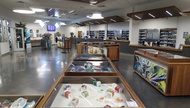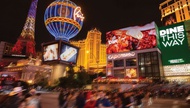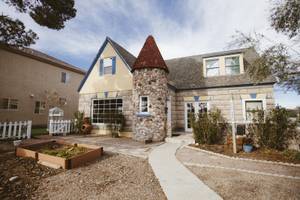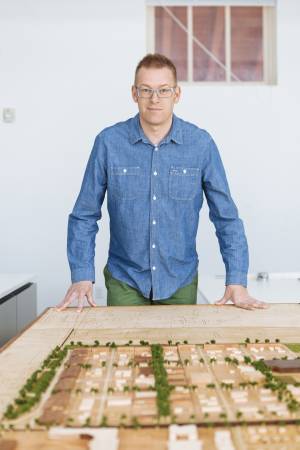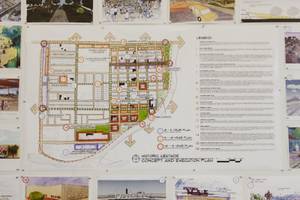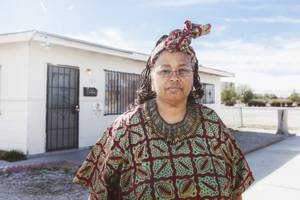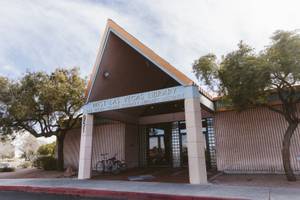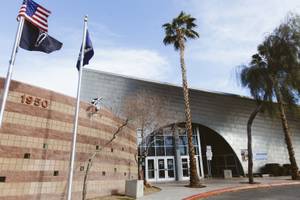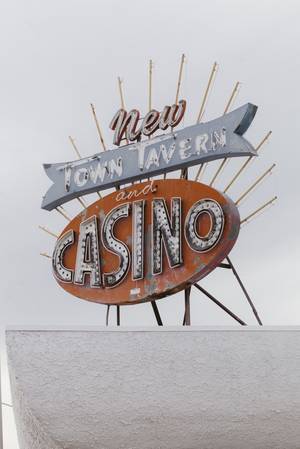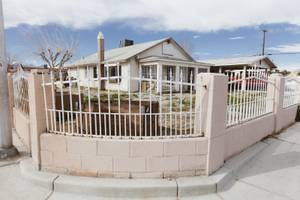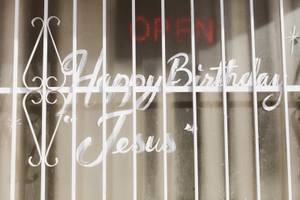It’s quiet at the corner of Jackson Avenue and F Street, where empty lots and vacant buildings define the historic landscape. A man rides by on his bicycle. A car occasionally passes through the intersection, and a security guard sits down on a chair outside the old New Town Tavern.
Pastor William McCurdy pulls up to check on renovations inside the tavern, slated to become a casino named the Tokyo. The dilapidated apartments across F Street are coming down, he says, for a new parking garage.
We look south and settle our eyes on the Historic Westside sign on the F Street underpass, the outcome of a contentious freeway-widening project that for six years blocked F Street with a concrete wall, severing it from Downtown and echoing a tumultuous history of segregation.
McCurdy has lived in this area most of his life. He points to a building that used to be the Jackson Community Center, where he played as a kid, and to the next block over, where there once was a bowling alley. “I’ve seen it in its glory days. I’ve seen the decline,” he says. “I want it to be revitalized. I want to see people be employed. I want to see homes built. You need rooftops to support businesses. It’s very important that we have the same amenities as they do across town.”
Segregation built this neighborhood. Desegregation led to its decline. And architecture tells the story. In the 1930s, African Americans were pushed to the Westside as business licenses were no longer issued to them elsewhere. Projects like the Hoover Dam brought workers from all over the country, including the South, where segregation was a way of life. Residents lacked amenities and adequate housing, but the growing community built up the neighborhood, turning Jackson Avenue into a bustling hub of businesses and nightclubs like the Brown Derby and the Cotton Club. The area drew celebrities white and black, from Frank Sinatra to Eartha Kitt.
“At one time the Westside was the sole black community—the only area where African Americans could live,” says Claytee White, director of UNLV’s Oral History Research Center, who would like to see that history recognized and celebrated for its uniqueness and past limitations, along with the foundation it provides for the “limitless possibilities of the future.”
Longtime residents remember how desegregation allowed African Americans to live and work elsewhere in the Valley. The core population took a hit, but the Westside is still vibrant.
“It is the black cultural hub, where churches are still attended by over 18,000 blacks on Sunday mornings,” White says, adding that ideas from the redevelopment taking place a half-mile away Downtown could be transferred across the tracks, “making this area viable again in this new era.”
The Plan
At UNLV’s Downtown Design Center, director Steven Clarke discusses renderings of the Westside, part of the HUNDRED Plan, an acronym for Historic Urban Neighborhood Design Redevelopment. It originated in 2014, when Councilman Ricki Barlow approached the Design Center about revitalizing the Westside. Clarke, who took over the arm of the School of Architecture that year, inherited the plan funded through the Las Vegas Historic Preservation Commission’s Centennial Legacy Grant. He learned there were five Westside redevelopment plans on the shelf, one a largely academic in-house study he reworked to include input from residents, about 200 attending an intensive planning meeting over three days.
Clarke and a team of architecture students, faculty and local and international design consultants listened to the community. On provided name tags, attendees were asked to write one word describing what the Westside meant to them. The most common word was home, “whether they lived there or not.”
“The historic Westside is a community that’s full of passion. They have a lot to say about their community,” Clarke says. “It wasn’t just people who lived in the area but people who had a stake in the community, African Americans who had lived there, and people who’d left because they could.”
The HUNDRED vision sees Washington Avenue becoming the entertainment corridor celebrating the African American experience; a stepping stone to Downtown. Jackson Avenue would thrive again, bookended by Jackson Memorial Park and Plaza and the Walker African American Museum. Housing design would reference the community’s historical landscape. “The Westside is so unique and so different from other parts of the city,” Clarke says. “It has its own architecture and building typologies. There are opportunities for innovations in urban downtown living. People think density means towers.”
This plan favors cottage clusters, and nothing more than three stories. “We’re currently working with Councilman Barlow and the City of Las Vegas to transition the HUNDRED Plan to the City,” Clarke says. “Our hope is to have the plan grafted as part of the Vision Las Vegas Downtown 2035 Plan.”
City Council approval would give the HUNDRED official status and help guide economic investment in the Westside, something UNLV’s Claytee White sees as advantageous for all of Las Vegas. “The redevelopment of Downtown shows that our tourists are more sophisticated than we thought,” she says. “This is an area that is equally rich in potential. The cultural arts center/library is the core of the community, allowing plays, poetry sessions of all types, arts exhibits, readings and celebrations. Those celebrations could eventually spill over into the revitalized Jackson Avenue corridor, bringing in tourist dollars and sharing Westside history.”
The Collector
There was a time when Gwen Walker hit thrift shops, antique stores, yard sales and swap meets incognito. Local papers had been writing about her, and she didn’t want sellers recognizing her and jacking up prices.
She’d been on a bender, buying anything that had anything to do with black people: paintings, old newspapers, statues, books, postcards, consumer products, photos of black models in print ads and a Michael Jackson doll. Politics, business, sports, education, pop culture. Not just Americans—Russian writer Alexander Pushkin and French author Alexandre Dumas. “Anything that has a black face, was written by blacks or African Americans or written about blacks or African Americans.” Walker will even request a magazine in her doctor’s office if there’s an African American on the cover, or settle for a photo copy.
Her life’s work is a perfect art project evolving with the calendar—a collection where African Americans aren’t absent, remedying a situation from her youth. Assigned a school report on black history at age 13, she couldn’t find the necessary resources in her school library. This, despite growing up in a predominantly African American community adjacent to the Westside.
A world opened up when her mother bought her the Negro Heritage Library—an inspiration and a great resource, she says, for someone who wasn’t being taught contributions by African Americans in school, save for Black History Month, “the shortest month of the year.”
Her Walker African American History Museum sits in a small house on West Van Buren Avenue. It opened in the ’90s, after collecting became Walker’s drive. She’d quit smoking and used her saved cigarette money to hit yard sales, not planning at first to display her bounty. She doesn’t know how much she has, because she never stopped collecting.
Unfortunately, 90 percent of that vast collection is temporarily stored elsewhere. There have been burst pipes, floods and break-ins, but Walker’s plan remains undeterred. Her mother owns two parcels where the museum sits, and they want to buy a third. Either way, the HUNDRED Plan has the museum anchoring Jackson Avenue.
“My love for finding about our history made me proud and our children proud,” says Walker, whose Black Pioneers of Nevada publication is at the West Las Vegas Library. “I used to go with suitcases to churches and rec-rooms and talk about the importance of preserving our heritage. We’re hoping to build a permanent facility, if not here where we are, then wherever God puts us so that legacy lives on.”
Cultural Core
The West Las Vegas Arts Center is hopping on a Saturday afternoon, an improvisational composition of rhythm and motion. Cars move through the full lots, engines humming, doors opening and closing. Conversations buzz around the campus as basketballs pound the nearby courts. This is the cultural epicenter of West Las Vegas.
Inside, artist John Trimble is greeting guests for the opening of his new exhibit The Hues of Souls. Jazz music in the gallery is met with drums in the dance room, young bodies moving to the spontaneous syncopation. Staff members, darting from room to room, stop to answer questions, chat and offer directions, but pretty much everyone knows where they’re going.
Launched in 1995, this is the center for discussion groups, cultural events, readings, dance classes, rites of passage—whatever serves the community. The night before Trimble’s opening, Dr. Tiffany Tyler led a discussion as part of an educational and cultural series. Today, appetizers fill the table. The upright piano is covered with patterned fabric, and Trimble is talking about “Choir Practice,” a piece he finished after meeting black artist Synthia Saint James, whose work was featured on The Cosby Show. It hangs near a painting of Spyro Gyra from when the jazz fusion band played at Jazz in the Park. Jazz inspires his work, he says, surrounded by paintings in bold colors of beach scenes and jazz musicians.
Around the corner on J Street, families and clusters of kids pour out of Doolittle Community Center carrying trophies while basketball games take place in the gymnasiums inside. It’s one big campus coming together, the West Las Vegas Arts Center, the West Las Vegas Theater, the West Las Vegas Library and the long-standing Doolittle.
Marcia Robinson, who heads the arts center, grew up in East St. Louis, Illinois, received her MFA from University of California San Diego and has a doctorate in education from UNLV. The former dancer in Hallelujah Hollywood! at the MGM Grand and Jubilee has been director since the center opened. She emphasizes mentoring, given her experience with African American choreographer Katherine Dunham. “Our program is socialization through the arts. As Katherine Dunham says, I see it as taking the edges off their lives and trying to channel them into ways of thinking and behaving that will help them in other parts of the world,” Robinson says. “I’m one of those young people.”
Preservation
The telling of Las Vegas’ story isn’t complete without the Westside. The neighborhoods are dotted with dedication markers of the Pioneer Trail, established by the city, county and community as a “journey through early Las Vegas.”
The Moulin Rouge—the first integrated casino, and site of the Moulin Rouge Agreement that legally ended segregation of Strip casinos—is gone, but the Harrison House still stands at 1001 F Street, where in the ’40s and ’50s Genevieve Harrison housed black entertainers. There’s Jackson Avenue, which thrived during segregation, and the Westside School on Washington Avenue, built in 1923 and the oldest standing schoolhouse in Las Vegas.
“The Historic Westside contains some of the oldest buildings in Las Vegas, ranging in styles from vernacular to popular 1920s and 1930s styles like bungalow and mission revival. There are a fair amount of mid-century-style buildings as well,” says Courtney Mooney, urban design coordinator and historic preservation officer for the City of Las Vegas. “The vernacular architecture is one feature that sets this area apart as there is not a lot of it left in the city.” The area is bounded by what is now West Bonanza Road, H Street, West Washington Avenue and the railroad tracks, Mooney says, and was the city’s first urban development. “It beat the east side of the tracks by a few months. Through a series of unfortunate events and eventually de facto segregation, the area was effectively cut off from the emerging development on the east side and left to languish for many years. Because of this, people forget how important the area is to our collective history.”
Mooney was involved in getting West Las Vegas’ Berkley Square neighborhood listed on the National Register of Historic Places in 2009, following the listing of the Westside School (1979) and the Moulin Rouge (1992, though a 2009 fire led to its eventual demolition). Constructed from 1954 to 1955 near Owens Avenue and D Street, Berkley Square was the first minority-built subdivision in Nevada.
The 148 one-story, rectangular, ranch-style homes were designed to be atmospherically middle-class and to improve living conditions on the Westside. The development was financed in part by Thomas L. Berkley, a prominent attorney, media owner, developer and civil rights activist from Oakland, California. In 2012, Las Vegas artist Joseph Watson was commissioned to create banners that hang throughout the neighborhood.
In an oral-history interview with Berkley Square resident Ruth Eppenger D’Hondt, Claytee White asks about discussions D’Hondt’s family had about race relations in Las Vegas while sitting around in the first African American subdivision designed by black LA architect Paul Revere Williams.
“We didn’t sit around,” D’Hondt told her. “We worked.”
Work and perseverance defined the struggles and triumphs of a marginalized community living without equal employment opportunities and services. Survival meant being resourceful—working two jobs or running a family business, making ends meet against the odds. Some left for other parts of the Valley when segregation ended, but so many stayed. D’Hondt still lives in Berkley Square, and has fought to keep it together while watching it crumble as careless tenants and absent landlords take over—a reality that has hit many Las Vegas neighborhoods as sprawl has crept outward.
But this area is championed. Residents successfully fought to reopen F Street, connecting them to Downtown redevelopment. The city-owned Westside School is under renovation. A portion of it is slated to be a museum celebrating the rich history of the community, says Barlow, who attended Head Start there as a child. (The campus also includes a 1948 building, housing nonprofit public radio station KCEP.) The school’s history stretches back to racially integrated classes in the ’20s, and it’s being restored using oral histories and memorabilia.
“Preserving this historic school is important because it will serve to culturally enrich our community,” Barlow said in 2010, when he and the city were organizing workshops and open houses. The sentiment resonates, that a community should put a premium on honoring its roots. “Lessons learned from the past help us to set our sights and accomplish where we need to be in the future. By preserving this historic building we are leaving something for future generations, and that is something to be proud of.”

